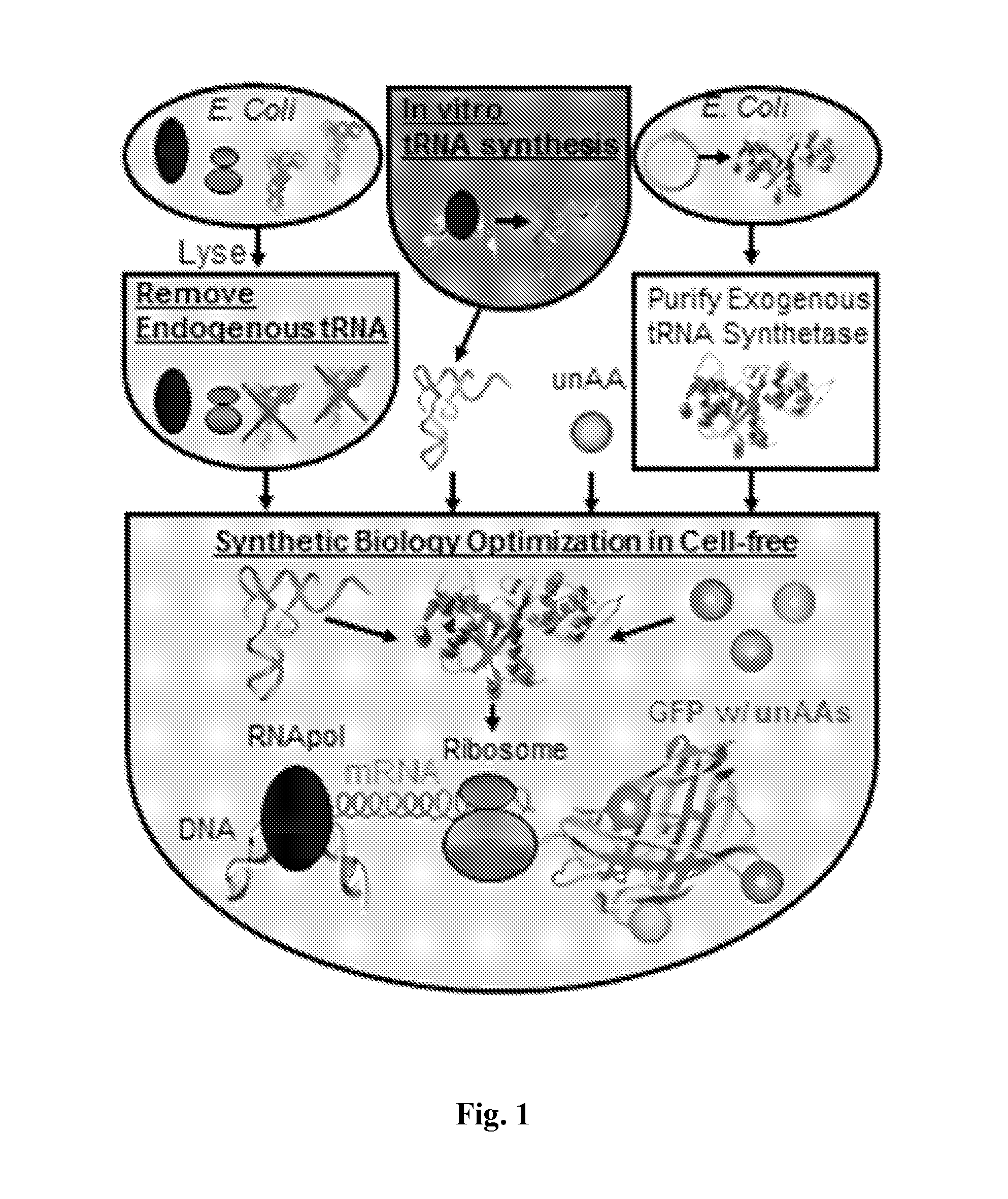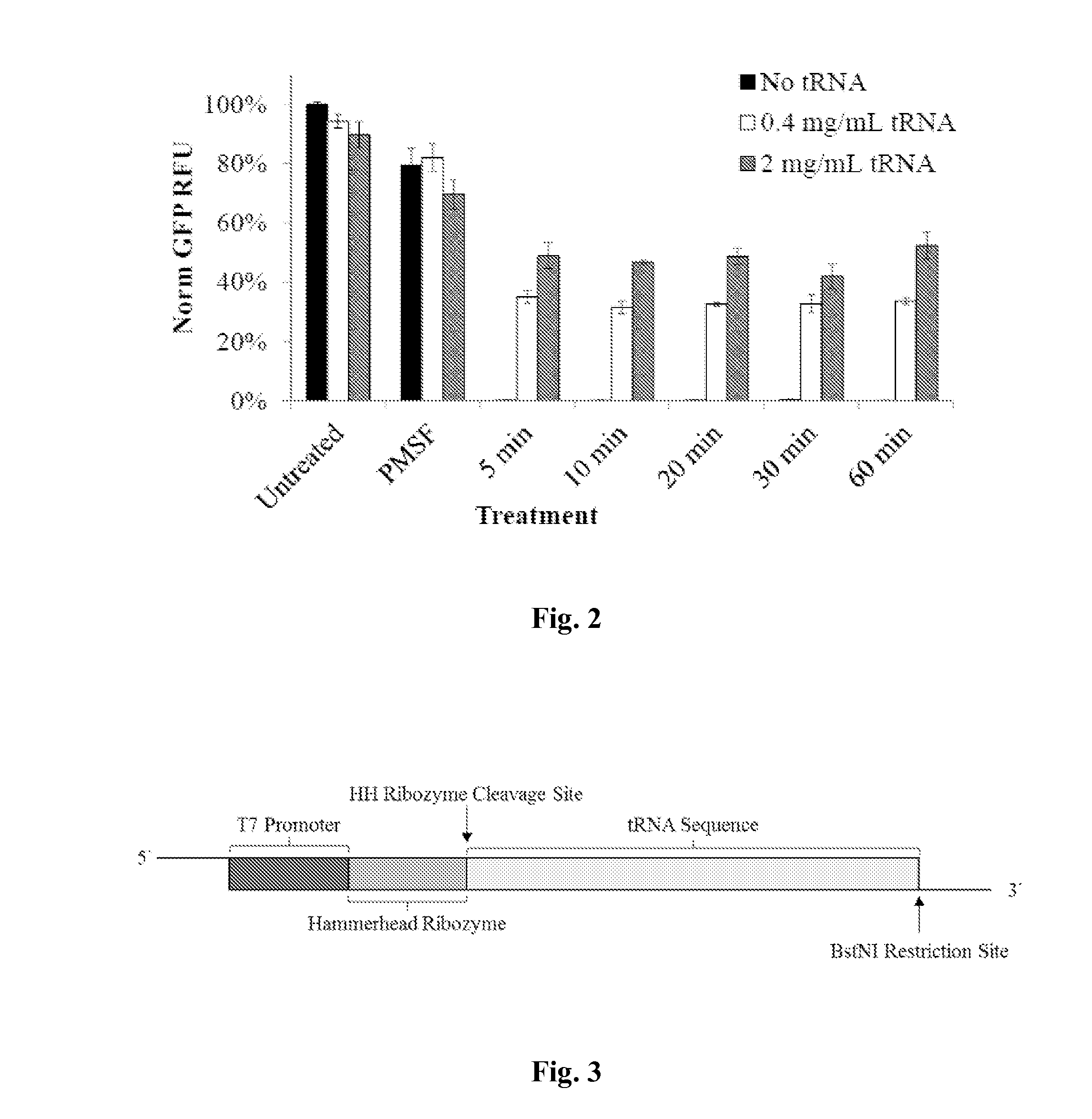Cell-free synthetic incorporation of non-natural amino acids into proteins
a technology of non-natural amino acids and protein, applied in the field of protein engineering and protein biosynthesis, can solve the problems of inefficient and inaccurate nnaa incorporation,
- Summary
- Abstract
- Description
- Claims
- Application Information
AI Technical Summary
Benefits of technology
Problems solved by technology
Method used
Image
Examples
example 1
Methods for Removing Endogenous tRNA in the Cell-Free Protein Synthesis System
[0058]Extract Pretreatment: Escherichia coli strain BL21 Star DE3™ (Invitrogen, USA) cells were used to prepare the extract. The cell extract can be prepared, aliquoted, and flash-frozen in liquid nitrogen for storage at −80 degrees Celsius. (Calhoun et al. (2005) Biotechnol Progr. 21:1146-53). Prior to use, the cell extract was thawed on ice and subsequently centrifuged at 16000×g for 10 minutes. The resulting supernatant was used in the CFPS system described herein.
[0059]In an exemplary embodiment, RNAse A columns with RNAses immobilized on matrix material or Superparamagnetic beads were used to degrade the tRNAs in an E. coli cell-free extract. In some embodiments, the ribonuclease which is immobilized on the beads can also be recycled.
[0060]RNAse A Immobilization on Superparamagnetic Beads: Bovine pancreas RNAse A (Sigma Aldrich, USA) was incubated with epoxy-functionalized M-270 Dynabeads (Life Techno...
example 2
In Vitro Synthesis of tRNA
[0064]The protein synthesized with the methods disclosed herein can be either a polypeptide with both natural amino acids and non-natural amino acids incorporated or can be an entirely synthetic protein construct which incorporate non-natural amino acids only.
[0065]In some embodiments, both the orthogonal tRNAs and tRNAs for natural amino acids can be made with an RNA polymerase and a tRNA gene template comprising the gene sequences of the tRNA. In some embodiments, as shown in FIG. 3, the tRNA gene template can be a linear expression template. The synthetic tRNA genes can be designed to produce the final RNA product with appropriate 5′ and 3′ termini for tRNA. The linear tRNA templates can be generated de novo with the desired anti-codon using a single-step or two-step PCR. In some embodiments, a hammerhead ribozyme cleaves the 5′ end appropriately, while the 3′ end is digested prior to transcription to allow the T7 RNAP to terminate transcription by relea...
example 3
Cell-Free Protein Synthesis by Coexpression of Tranzyme RNA in tRNA-Depleted Extract
[0073]Example Gene: A test gene was designed to produce poly-valine, with the specific nucleotide sequence
(SEQ ID NO: 44)ATG-(GTA)20(ATGGTAAGTAGTAGTAGTAGTAGTAGTAGTAGTAGTAGTAGTAGTAGTAGTAGTAGTAGTAGTA) for the protein (SEQ ID NO: 45)Met-(Val)20(MVVVVVVVVVVVVVVVVVVVV).
[0074]CFPS Reaction: Reactions were performed as described in example 1 with RNAse treated extracts and the following modifications. The plasmid added for the gene of interest encoded for the test gene PolyValn. LETs encoding for tranzymes of fMetCAU and ValUAC were included in the reaction at 50 and 100 μg / mL, respectively. Radiolabeled 14-C Val was included in the reaction mixture at 5.25 μM. In the negative control case, no tRNA nor tranzyme LETs were added. For the positive control, bulk purified E. coli tRNA was added a 2 μg / mL.
[0075]Protein Yield Quantification: Total and incorporated radiolabeled protein was quantified using 5% v / v T...
PUM
| Property | Measurement | Unit |
|---|---|---|
| concentrations | aaaaa | aaaaa |
| volumes | aaaaa | aaaaa |
| pH | aaaaa | aaaaa |
Abstract
Description
Claims
Application Information
 Login to View More
Login to View More - R&D
- Intellectual Property
- Life Sciences
- Materials
- Tech Scout
- Unparalleled Data Quality
- Higher Quality Content
- 60% Fewer Hallucinations
Browse by: Latest US Patents, China's latest patents, Technical Efficacy Thesaurus, Application Domain, Technology Topic, Popular Technical Reports.
© 2025 PatSnap. All rights reserved.Legal|Privacy policy|Modern Slavery Act Transparency Statement|Sitemap|About US| Contact US: help@patsnap.com



